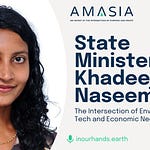In this episode of In Our Hands, Ramanan Raghavendran delves into the environmental impact of AI technologies with renowned scholar Kate Crawford. They discuss the interdisciplinary nature of her work, focusing on the implications of AI technology on society, the environment, and labor. They explore the materiality of AI, its environmental costs, and the biases inherent in AI systems.
Click above for the full transcript. This episode is also available on Apple Podcasts and Spotify.
In Our Hands is a production of Amasia. Follow these links for more about our firm, the Amasia blog, our climate fiction podcast, and Ramanan’s blog.
Highlights
02:15 Interdisciplinary Foundations of AI and Technology
04:19 The Material Reality of AI
07:40 Environmental Costs of AI
9:52 The Impact of Rare Earth Mining
12:04 Environmental Costs of AI
21:45 Policy Measures for AI Governance
31:37 The Future of AI and Collective Responsibility
37:12 AI In Education and Pedagogy









